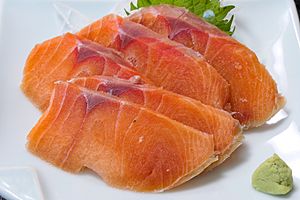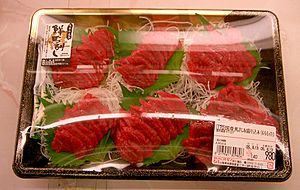Japanese regional cuisine facts for kids
Japan is famous for its amazing food, and did you know that different parts of Japan have their own special dishes? These are called regional specialities or kyōdo ryōri in Japanese. Many of these tasty foods started from local ingredients and old family recipes.
Even though you can find many ingredients all over Japan now, and some dishes like okonomiyaki and Edo-style sushi are popular everywhere, lots of regional specialities are still unique to their areas. New ones are even being created today!
You can also see regional differences in common dishes like zōni soup. For example, the soup for udon noodles in eastern Japan uses a dark soy sauce. But in western Japan, the soup has a lighter soy sauce and a richer dashi (broth) flavor.
Contents
How Regional Foods Began
Japanese regional specialities have interesting stories about how they started. We can group their origins into four main types:
- Traditional Foods: These dishes came from local ingredients before people had refrigerators. They used what was fresh and available nearby.
- Late 1800s and Early 1900s: After Japan opened up to the world in 1886 during the Meiji Restoration, new foods and cooking styles arrived. This led to many new dishes being invented across Japan.
- After World War II: During times of food shortages, people got creative! They made new dishes from the ingredients they had. Some returning soldiers even brought back recipes from other countries.
- Modern Creations: Today, chefs invent new dishes that become popular locally. Sometimes, local businesses or tourist groups also promote certain foods as regional specialities.
Discover Japan's Regional Dishes
Hokkaido's Unique Flavors
- Genghis Khan Barbecue: This dish features lamb and vegetables cooked on a grill, often right at your table. It's a fun way to eat!
- Ishikari-nabe: A warm nabemono (hot pot) dish. It has salmon pieces and vegetables stewed in a tasty miso-based soup.
- Ruibe: An old Ainu speciality. It's thinly sliced, raw, frozen salmon. Traditionally, it was frozen naturally outside, and people eat it like sashimi.
- Hokkaido Ramen: Many cities in Hokkaido have their own types of ramen. But Sapporo ramen, with its rich broth, is famous all over Japan.
- Ika sōmen: From the Hakodate area, this dish has squid sliced into very thin, noodle-like strips. You eat it with a dipping sauce, just like sōmen noodles.
Tohoku Region's Hearty Meals
- Ichigo-ni: A clear soup from the Pacific coast of Aomori Prefecture. It's made with thinly sliced sea urchin roe and abalone.
- Wanko soba: In Iwate Prefecture, soba noodles are served in tiny bowls. As soon as you finish one, it's refilled again and again!
- Morioka Reimen: A cold noodle soup from Morioka city. It's a Japanese version of a North Korean dish, brought by Korean immigrants.
- Harako-meshi: Rice cooked in a salmon and soy broth. It's topped with ikura (salmon caviar).
- Kiritanpo: Pounded rice cakes wrapped around a stick and grilled. You can eat them with miso or stewed with chicken and vegetables in a hot pot.
- Gyūtan: This dish from Sendai city features beef tongue. It's usually grilled, but you can find it prepared in many ways, even raw like sashimi.
Chubu and Kanto Regions' Delights
- Inago no tsukudani: A unique dish where Inago (a type of grasshopper) is stewed in sweetened soy sauce. You'll find this in rural areas like Nagano.
- Hōtō: Thick udon noodles stewed in a miso-based soup. It often includes vegetables like pumpkin or potatoes, mushrooms, and sometimes meat. It's usually served in a heavy cast-iron pot.
- Monja-yaki: A savory pancake from Tokyo, similar to okonomiyaki. It's much runnier and eaten directly off the grill with a small metal spatula. It's a classic comfort food.
- Edo-mae-zushi: What most people around the world call "sushi" is actually this type of sushi. It started in Tokyo (then called Edo) around the 1820s.
- Masuzushi: From Toyama Prefecture, this dish has trout placed on a circular bed of rice. It's steamed while wrapped in bamboo leaves.
- Miso nikomi udon: Udon noodles stewed in a broth flavored with a special hatcho-miso. This is popular in Nagoya and nearby areas.
- Miso-katsu: A delicious tonkatsu (breaded pork cutlet) served with a special miso-based sauce. You'll find this in Nagoya too.
- Kishimen: A type of flat udon noodle, also a speciality of Nagoya.
Kansai and Chugoku Regions' Favorites
- Yudofu: In Kyoto, this dish features tofu gently simmered in hot water with kombu (seaweed). You eat it with different dipping sauces.
- Osaka zushi: Also called Hako zushi ("box sushi"), this sushi is pressed into a rectangular shape.
- Okonomiyaki: A savory pancake filled with cabbage, meat, or seafood. It's topped with Japanese worcestershire sauce and mayonnaise.
- Osaka style: All ingredients are mixed into the batter before cooking. This style is now popular across Japan.
- Hiroshima style: Made in layers, with batter, cabbage, toppings, yakisoba noodles, and a fried egg.
- Takoyaki: Small, grilled, savory balls with pieces of octopus inside. These are very popular throughout Japan and originated in Osaka.
- Akashiyaki: From Akashi, Hyōgo, this is an older version of takoyaki balls.
- Fugu: Dishes made from fugu (pufferfish) are famous in Shimonoseki and also popular in Osaka. Fugu must be prepared by specially trained chefs because parts of it are poisonous.
Shikoku Island's Specialities
- Katsuo no tataki: In the Kochi area, this means finely chopped skipjack tuna mixed with spring onion and seasoned with rice vinegar.
- Sanuki udon: Udon noodles from Kagawa Prefecture are incredibly popular and famous nationwide for their chewy texture.
- Sawachi ryori: A traditional way of serving food in the Kochi area. Many different dishes, like sashimi and sushi, are presented on a huge plate called a "sawachi."
- Shoyumame: Roasted broad beans soaked overnight in a mixture of soy sauce, sugar, mirin, and sake. This is a speciality of Kagawa Prefecture.
- Sudachi: A tiny, lime-like citrus fruit. It's often grated and added to fish dishes in the Tokushima area to give them a fresh, summery taste.
Kyūshū Island's Delicious Dishes

- Mizutaki: A nabemono (hot pot) dish from Fukuoka. It has chicken and vegetables cooked in broth, served with a ponzu dipping sauce.
- Hakata Ramen: From Hakata, this ramen has noodles served in a rich tonkotsu (pork bone broth) soup. It comes with unique toppings like pickled ginger and sesame seeds. Many restaurants let you ask for more noodles (called kaedama) to add to your leftover soup!
- Motsunabe: Another nabemono dish from Fukuoka, made with beef or pork offal.
- Mentaiko: Spicy fish eggs from Fukuoka, often eaten with rice.
- Champon: A ramen-like dish from Nagasaki. Noodles, seafood, and vegetables are all cooked together in the same pot.
- Castella: A sweet, rectangular sponge cake. It was brought to Nagasaki by the Portuguese in the 1500s and is now popular all over Japan.
- Chicken namban: Fried, battered chicken from Miyazaki Prefecture. It's dipped in a vinegary sauce and served with tartar sauce.
- Kakuni: Pork belly stewed in a sweetened soy-based broth until it's super soft. You can find this in Nagasaki and Kagoshima.
- Tonkotsu: In Kagoshima, this refers to pork ribs simmered for hours in shochu, miso, and black sugar. Don't confuse it with Tonkotsu ramen!
- Toriten: Tempura chicken from Ōita Prefecture. You can dip it in a soy sauce-based sauce.
Okinawa's Tropical Tastes
- Chanpurū: This is a type of Okinawan stir-fry.
- Gōyā chanpurū: Gōyā (bitter melon) stir-fried with other vegetables, tofu, and either Spam, bacon, thin pork belly, or canned tuna.
- Tōfu chanpurū: Firm Okinawan tofu stir-fried with vegetables and Spam, bacon, thin pork belly, or canned tuna.
- Rafute: Delicious stewed pork belly, cooked until it's very tender.
- Soki: Stewed pork ribs, another popular Okinawan dish.
- Okinawa soba: A noodle soup that looks a bit like udon. It's often topped with soki (pork ribs), which is why it's sometimes called "soki-soba."
- Taco rice: Invented in the 1960s, this dish has taco meat served over rice and lettuce. It often comes with tomato, cucumber, cheese, and salsa on top.
Various Regional Dishes
- Fugu cuisine: Various dishes made from fugu (pufferfish), like sashimi and hot pot. These are popular in Yamaguchi Prefecture, northern Kyūshū, and Osaka.
- Botan nabe: A nabemono (hot pot) dish made with wild boar meat. You can find this in different places, especially the Tanzawa region and the Tanba region.
- Basashi: This is horse meat served raw, like sashimi. It's a speciality in the Kumamoto area, Matsumoto area, and rural Tōhoku.



